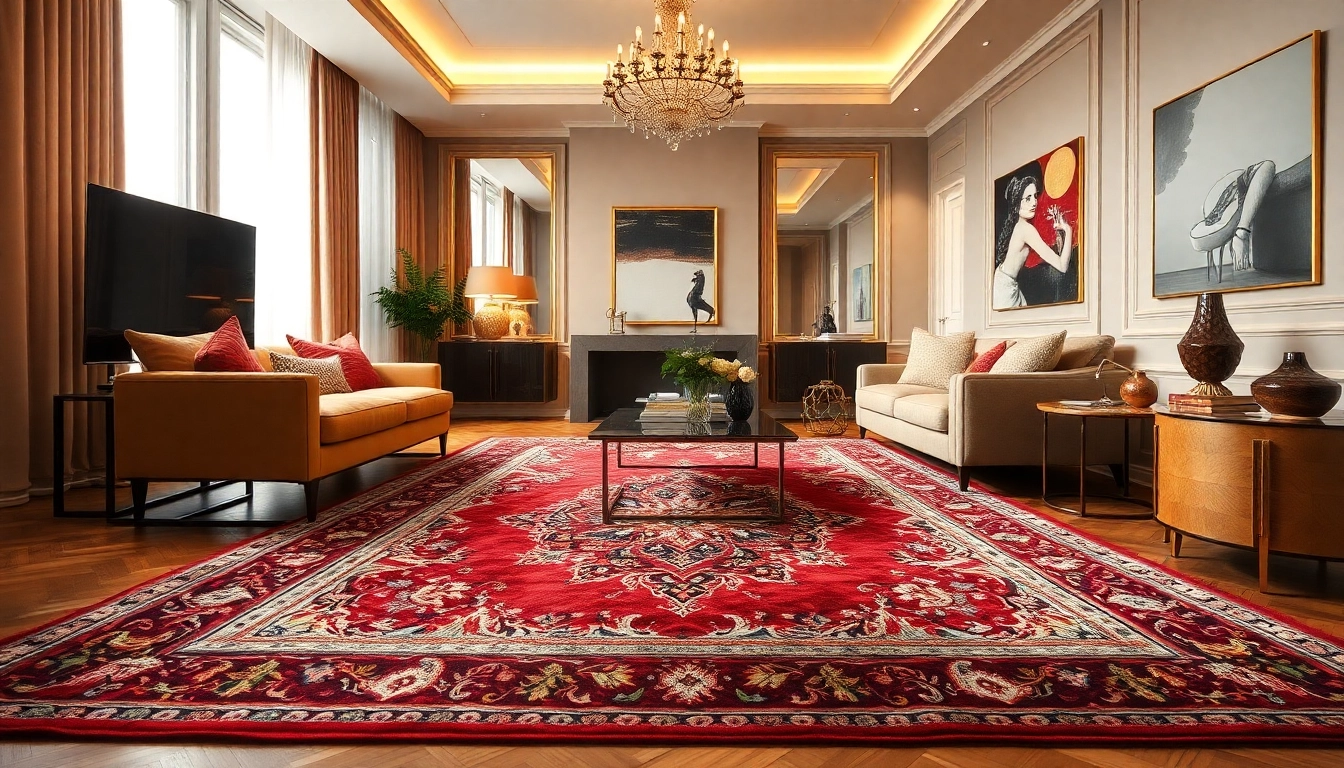Introduction to Tappeto Persiano Milano: Craftsmanship and Heritage
The allure of Tappeto persiano Milano lies in its rich history, exquisite craftsmanship, and timeless elegance. These authentic Persian rugs are more than just decorative pieces; they embody centuries of cultural heritage, artistic mastery, and meticulous handcrafting traditions passed down through generations. In Milan, a city renowned for its fashion, design, and luxury, the adoption of Persian rugs reflects a sophisticated taste and an appreciation for art that transcends mere aesthetics. Exploring the craftsmanship behind these rugs reveals a world where each knot, color, and motif bears significance, often inspired by Persian poetry, history, and nature.
This article aims to provide an in-depth understanding of Persian rugs in Milan—from their historical roots and unique qualities to buying guides, care tips, and investment strategies—helping enthusiasts and connoisseurs alike make informed decisions when acquiring or maintaining a piece of this cultural treasure.
History and Tradition of Persian Rugs in Milan
Persian rugs have long been symbols of luxury and artistry, originating from Iran’s ancient cities such as Tabriz, Ghom, and Qom, renowned for their high-quality wool, silk, and intricate designs. Their journey into Milan’s luxurious interiors dates back to the late 19th and early 20th centuries, driven by Europe’s fascination with Oriental art and the increasing demand for exotic, handcrafted furnishings in European aristocratic circles.
During the Ottoman Empire and subsequent periods, Persian craftsmanship spread and evolved, influencing local artisans and collectors across Europe, Milan included. Today, the city hosts a thriving market of authentic Persian rugs, with numerous showrooms and galleries showcasing antique and modern pieces that continue this age-old tradition.
Milan’s reputation as a fashion and design capital makes it an ideal hub for this heritage, where historical pieces coexist with contemporary reinterpretations. The integration of Persian artistry into modern interior design underscores its enduring appeal, maintained through skilled craftsmanship, authentic sourcing, and a vibrant cultural dialogue.
What Makes a Tappeto Persiano Unique?
Authentic Persian rugs are distinguished by their exceptional craftsmanship, artistic motifs, and high-quality materials. Unlike machine-made imitations, genuine Tappeti Persiani are woven by hand using traditional knotting techniques, often involving thousands of knots per square meter, which ensures durability and intricate detail.
Key features that define their uniqueness include:
- Handknotted Weaving Technique: Each rug is crafted knot-by-knot, a process that can take months or even years, depending on size and complexity.
- Natural Materials: Premium wool, silk, and cotton are typically used, which contribute to the rug’s sheen, softness, and longevity.
- Complex Designs & Motifs: Persian rugs feature floral, medallion, geometric, and pictorial patterns often rooted in Persian culture, mythology, and history.
- Coloration: Natural dyes derived from plants, minerals, and insects produce vibrant, lasting colors that age gracefully over time.
This combination of craftsmanship, materials, and artistry makes each Persian rug a unique piece of cultural expression, with variations that reflect regional styles, individual artisan techniques, and personal touches.
Why Choose Authentic Persian Rugs for Your Home
Incorporating a genuine Persian rug into your interior design elevates the space with a sense of warmth, history, and luxury. Here are some compelling reasons to select authentic Tappeti Persiani:
- Timeless Elegance: Persian rugs are versatile, complementing both classical and contemporary decor styles.
- Durability and Longevity: Properly maintained, these rugs can last for generations, transforming into family heirlooms.
- Investment Value: Due to their craftsmanship and rarity, genuine Persian rugs often appreciate in value over time.
- Cultural Connection: Owning such a piece fosters an appreciation for Persian artistry, history, and craftsmanship.
When selecting a Persian rug, buyers are not merely acquiring a decorative item but embracing a piece of history and art that enriches their living environment with authenticity and character.
Selecting the Perfect Tappeto Persiano Milano for Your Space
Design Styles: Classic, Modern, and Custom Options
The variety of design styles available in Persian rugs is immense, catering to diverse preferences.
– Classic Persian Patterns: Timeless medallions, floral motifs, and intricate borders ideal for traditional interiors.
– Modern Interpretations: Simplified patterns, contemporary color palettes, and minimalist designs suitable for modern spaces.
– Custom Creations: Some artisans and vendors offer bespoke options, allowing clients to choose motifs, size, and colors aligned with their interior aesthetic.
Size and Color Considerations
Carefully assessing the dimensions and color scheme of your space is vital. A large rug can anchor a living room, while smaller pieces suit bedrooms or entryways. When choosing colors, consider the existing palette and how the rug’s hues can either complement or accentuate the surroundings.
Quality Indicators and Materials to Look For
Authentic Persian rugs exhibit certain features:
– Dense, knot-rich pile with even weaving.
– Natural dyes with subtle variations, indicating hand-dyeing.
– Fine, symmetrical knots in high-quality pieces.
– Clear regional signatures, such as motifs specific to Tabriz or Ghom.
Buying Guide: Where to Find Tappeto Persiano Milano
Top Showrooms and Artisans in Milan
Milan boasts several reputable shops specializing in Persian and Oriental rugs. Showrooms like Artorient Milano offer extensive selections, from antique to modern reinterpretations. Other notable establishments include Toranj and Parsa Tappeti, which provide authentic, handknotted pieces with expert consultation.
Online Platforms and Trusted Sellers
For wider choices, online platforms such as Outlettappeti.com and specialized galleries provide curated collections. When purchasing online, verify authenticity certificates, seller reputation, and return policies to ensure genuine transactions.
Price Range and Value Assessment
Authentic Persian rugs typically range from €200 for smaller, semi-antique pieces to several thousands of euros for large, vintage, or silk carpets. Factors influencing pricing include material quality, age, complexity of design, and provenance. Buyers should weigh the artistic value and investment potential alongside their budget.
Care and Maintenance of Persian Rugs in Milan
Cleaning and Restoration Tips
Proper care ensures longevity. Regular vacuuming with a low-suction setting prevents dirt accumulation. Avoid harsh chemicals; instead, opt for professional cleaning services specializing in delicate, handwoven rugs. Restoration of worn or damaged pieces is best handled by trained artisans to preserve artistic integrity.
Longevity and Preservation Techniques
To maintain vibrancy, place rugs away from direct sunlight, and use rug pads to prevent slipping and reduce wear. Rotating the rug periodically promotes even fading and wear. Humidity control and pest prevention are also vital for preservation.
Professional Services for Repair and Restoration
Expert restorers can repair tears, reweave worn areas, and restore colors. Selecting experienced professionals with expertise in Persian textiles is essential for maintaining authenticity and value.
Investing in Tappeto Persiano Milano: Tips for Buyers and Collectors
Understanding Market Trends and Pricing
The market for Persian rugs is dynamic, influenced by factors such as age, rarity, and provenance. Current trends favor well-preserved antique pieces and modern reinterpretations by renowned artisans. Collectors should stay informed through reputable auction houses, galleries, and expert consultations.
Authenticity Verification and Certification
Authenticity can be verified through certificates of origin, detailed provenance records, and expert appraisal. Familiarity with regional motifs and knotting techniques helps distinguish genuine pieces from replicas.
Enhancing Your Space with a Timeless Piece
Integrating a Persian rug requires thoughtful placement—ideally centered on focal furniture, over hardwood floors, or as a statement piece in a minimal setting. Its timeless appeal guarantees enduring value, both aesthetic and monetary, making it a prudent investment.



